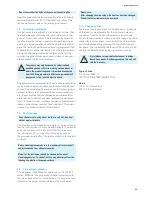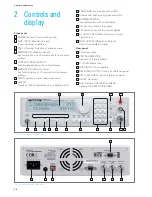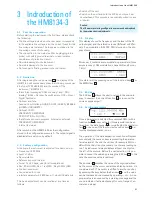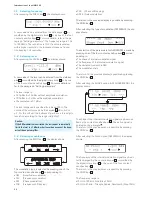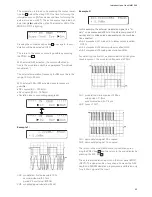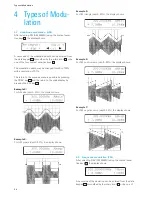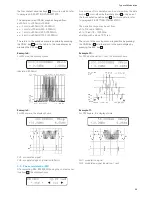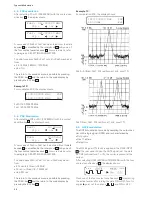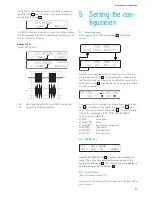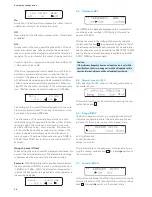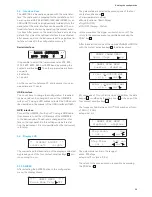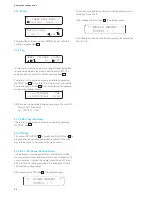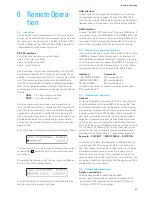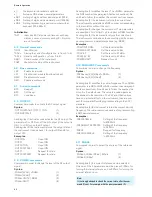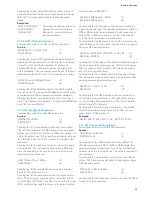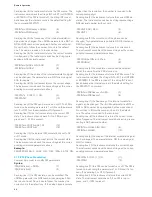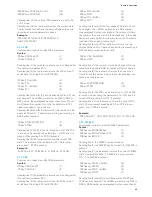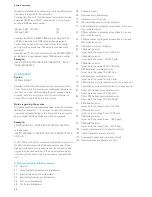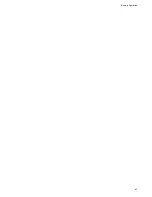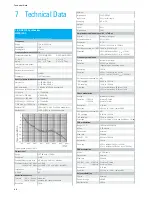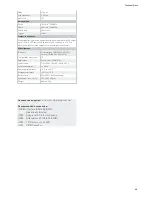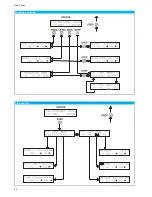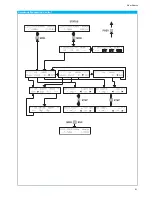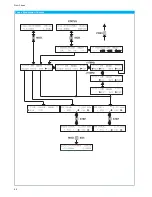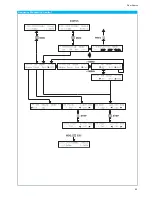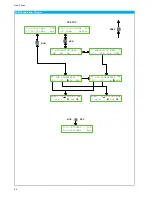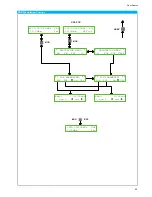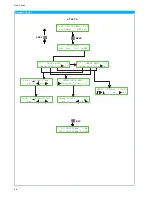
43
Remote Operation
Sending line (2) the instruments returns which source is
currently selected. The instrument sends back the strings
INT or EXT corresponding to the 2 options described
above.
Examples:
:PHAS:SOURCE EXT
Activating the external reference
:PHASE:SOUR?
Request for current reference
:PHAS:SOUR?
Request for current reference
(abbreviated
form)
6.12 PULM (PULse Modulation)
Commands in order to modify the GATE modulation.
Syntax:
:PULM:STATe 1 | ON | 0 | OFF
(1)
:PULM:STATe?
(2)
Sending line (1) the GATE modulation can be activated or
deactivated. The parameters 1 or ON turn the modulation
on and 0 or OFF turn the modulation off (if present).
Sending line (2) the instruments returns the state of the
GATE modulation. The instrument sends back 0, if the mo-
dulation is switched off, and 1, if the modulation is online.
:PULM:POLarity NORMal | INVert
(3)
:PULM:POLarity? (4)
Sending line (3) the validation level of the GATE modula-
tion can be set. The parameter NORMal represents high le-
vel validation and INVert represents low level validation.
Sending line (4) the instrument returns the current level
state. The instrument sends back 1 for high level (NORMal)
and 0 for low level (INVert).
6.13 AM (Amplitude Modulation)
Commands in order to modify AM parameters
Syntax:
:AM[:DEPTh]
<NUM>
(1)
:AM[:DEPTh]?
(2)
Sending line (1) the modulation depth can be modified.
The <NUM> parameter is a NR2 number (see paragraph
Syntax conventions). No unit has to follow the number, %
unit is the default one. If the value has an accuracy higher
than the resolution (0.1%), the number is rounded to the
resolution.
Sending line (2) the instrument returns the current depth
of modulation. The instruments sends back a NR2 num-
ber corresponding to the resolution (one digit after the
decimal point) without unit.
:AM:SOURce INTern | EXTern
(3)
:AM:SOURce?
(4)
Sending line (3) the modulation source can be selected
and the FM will be turned on.
Sending line (4) the instrument returns the source modu-
lation. The instrument sends back the strings INT or EXT
(not INTERN or EXTERN). If the AM is turned off, the string
INT is sent back because this source is the default setting
for the command AM:STAT 1 .
:AM:INTern:FREQuency <NUM>
(5)
:AM:INTern:FREQuency?
(6)
Sending line (5) the frequency of the internal modulation
signal can be changed. The <NUM> parameter is a NR1 or
NR2 or NR3 number (see paragraph Syntax conventions).
No unit has to follow the number, Hz unit is the default
one. The value is rounded to the resolution.
Sending line (6) the instruments returns the current modu-
lation frequency. The instrument sends back a string repre-
senting a NR3 decimal number.
:AM:INTern:SHAPe SIN | SQU | TRI | +RP | -RP
(7)
:AM:INTern:SHAPe?
(8)
Sending line (7) the shape of the internal modulation signal
can be changed.The parameters are: SIN for a sine signal,
SQU for square, TRI for triangle, +RP for a positive ramp
and –RP for a negative ramp.
Sending line (8) the instrument returns the current shape.
The instrument sends back the same strings as the corres-
ponding command parameters above.
:AM:STATe 0 | OFF | 1 | ON
(9)
:AM:STATe?
(10)
Sending line (9) the AM modulation can be turned on or
off. Sending the parameters 1 or ON, AM will be turned
on, and sending the parameters 0 or OFF, the modulation
will be turned off (if present).
Sending line (10) the instrument returns the current AM
state. The instrument sends back 0, if no AM is in pro-
gress, and 1, if AM is present.
Example:
:AM:INT:FREQ 1200; SHAP SQU; DEPT 60; STAT 1
6.14 FM (Frequency Modulation)
Commands in order to modify FM parameters
Syntax:
:FM[:DEViation]
<NUM>
(1)
:FM[:DEViation]?
(2)
Sending line (1) the FM deviation can be modified. The
<NUM> parameter is a NR1 or NR2 or NR3 number (see
paragraph Syntax conventions). No unit has to follow the
number, Hz unit is the default one. The value is rounded to
the resolution.
Sending line (2) the instrument returns the current FM de-
viation. The instrument sends back a string representing a
NR3 decimal number.
:FM:SOURce INTern | EXTern
(3)
:FM:SOURce?
(4)
Sending line (3) the modulation source is set and the FM is
turned on at the same time.
Summary of Contents for HM8134-3
Page 47: ...47 Remote Operation...
Page 50: ...50 Flow Charts Flow Charts Function selection Step control Phi Phi Phi...
Page 51: ...51 Flow Charts Amplitude Modulation Control FSK PSK GATE...
Page 52: ...52 Flow Charts Phase Modulation Control FSK PSK GATE...
Page 53: ...53 Flow Charts Frequency Modulation Control FSK PSK GATE...

